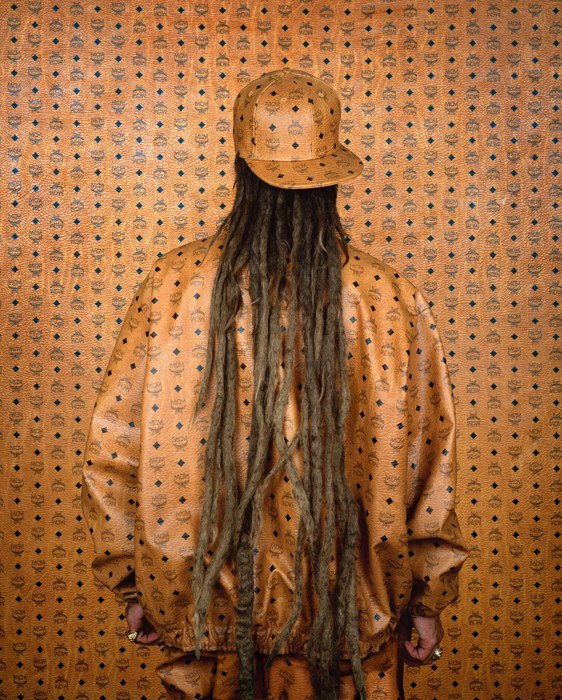
- Source: THE NEW YORK TIMES STYLE MAGAZINE
- Author: LINDA YABLONSKY
- Date: SEPTEMBER 07, 2011
- Format: DIGITAL
Artifacts
Logo à Go-Go

"Dreaded MCM"
A car is not just a road warrior. To many it’s a second home, except, that is, when it’s more like a handbag from Louis Vuitton. In that case, it’s simply a gas.
So are the photographs in Luis Gispert‘s “Decepcion,” a show at the Mary Boone Gallery spotlighting a subculture devoted to making both cars and clothes into personal showrooms for designer-logo fabrics. It’s not that members of this street-art underground are shilling for brands like Gucci, Fendi and Coach. The fabrics are counterfeit. But the designs are real bombs declaring a war on status.
Gone are the bobble-headed dashboard dogs and dangling dice from days of yore. The creators of these logomobiles are fashionistas aspiring to wealth and glamour they can own. One Escalade plunges passengers into a total Takashi Murakami “LV” environment. Another car’s interior is upholstered in the graffiti-scribbled, Day-Glo green patented by Stephen Sprouse. And another is screaming pink, with Coach “C” stirrups covering every surface surrounding its rosy leather seats. “It’s all about color coordination,” Gispert said the other day. “The paint job on the Sprouse car was also green, and the white Volkswagen’s Burberry lining was so bright, I needed sunglasses just to sit inside it.”
Gispert’s photographs, though life-size, are not strictly documentary. The windshields frame images of landscapes he made at different times of a frozen Lake Michigan, the California desert and the Grand Tetons far from the actual locations of the cars. But by equating natural splendor to a more bombastic human kind, he mirrors a tension between beauty and taste that both art and fashion create.
Gispert, 39, a Brooklynite born in Jersey City and raised in Latino Miami, was no stranger to low-rider culture when he set out to photograph cars that represent it. Most of his work as an artist has been a study in the aesthetics of taste within one society or another. But the wild, fashion-label customizations he stumbled on in car clubs across the country led him beyond any fetishes for long nails, loud jewelry or baroque decor he had unearthed before. And he found people hijacking the same counterfeited fabrics for their sneakers, prom clothes and T-shirts as others put into their cars. “They’re not knockoffs of luxury brands,” Gispert explained. “They’re interpretations.”
Aware that they are working with illicit goods, most of the people Gispert found were shy of modeling their designs for his camera. He won their confidence by photographing them from the back or from the neck down. A shot of a man whose sneakers matched his car focuses only on his feet. And a photograph of a bedroom decked out in Versace trimmings that have seen better days is, like the cars, absent of its owner.
To his credit, Gispert also made an effort not to comment on his subjects or their designs, because he identified with the nature of their commitment. “It’s the same as for an artist making aesthetic decisions in the studio,” he said. “Some kind of fantasy is being played out.”
What about his own wheels? “I drive an old Ford Explorer,” he said with a laugh. “It blends into every parking lot.”

